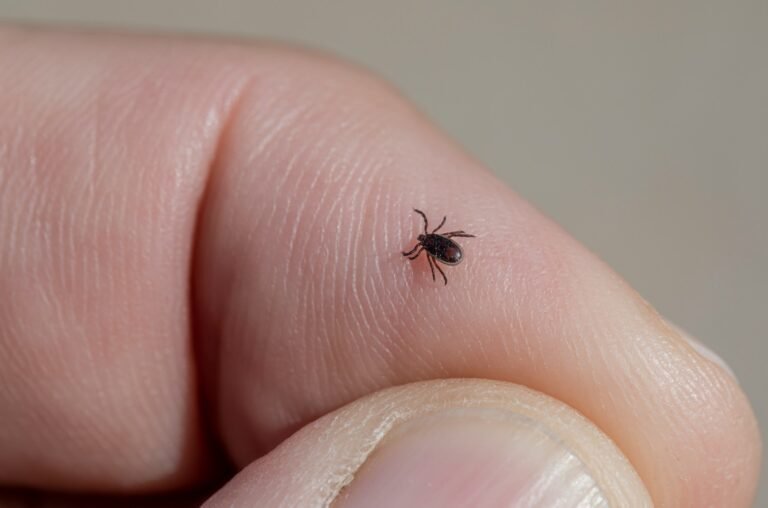Engorged ticks are a common concern for pet owners, outdoor enthusiasts, and anyone who spends time in nature. Among the various types of ticks, the deer tick (Ixodes scapularis), the American dog tick (Dermacentor variabilis), and the dog tick (Dermacentor variabilis) are two of the most well-known. Properly identifying these ticks is crucial, as they can carry different diseases and require different preventive measures. This comprehensive guide will help you distinguish between engorged deer ticks and engorged, brown dog tick or ticks, understand their habitats, the diseases they transmit, and how to manage and prevent tick infestations.

Key Takeaways on Engorged Deer Tick vs Engorged Dog Tick
1. Understanding Ticks
Ticks are small arachnids that feed on the blood of mammals animals, birds, and sometimes reptiles and amphibians. They go through four life stages: egg, larva, and nymphs, and adult. Deer tick nymphs appear in May and stay until August; they are incredibly small and often well hidden on the body. Ticks are most active in the spring and summer months, but they can be found year-round in some regions. Understanding their life cycle is important for effective prevention and control.
2. Physical Differences: Deer Tick vs. Dog Tick
Deer Tick (Ixodes scapularis)
- Size and Shape: Adult deer ticks are smaller than dog ticks, measuring about 2-3 mm unfed and up to 10 mm when engorged.
- Color: Unfed deer ticks are dark brown to black, with a reddish-orange body after feeding. Engorged ticks appear grayish-blue.
- Scutum (Shield): The scutum covers a small portion of the back, just behind the head.
- Mouthparts: Deer ticks have longer mouthparts compared to dog ticks.
Dog Tick (Dermacentor variabilis)
- Size and Shape: Adult dog ticks are larger, measuring about 5 mm unfed and up to 15 mm when engorged.
- Color: Unfed dog ticks are brown with white or grayish markings on their backs. Engorged ticks are slate gray.
- Scutum (Shield): The scutum covers a larger portion of the back.
- Mouthparts: Dog ticks have shorter and thicker mouthparts.
3. Habitats and Behavior
Deer Tick
- Habitat: Found in wooded areas, grasslands, and regions with high humidity. They are often found in the northeastern, mid-Atlantic, and upper midwestern United States. The Lone Star tick, mainly found in the Southern and Eastern U.S., can also be present in these areas.
- Behavior: Deer ticks are known for their ability to latch onto hosts in shaded, moist environments. They are particularly active during the cooler months of spring and fall.
Dog Tick
- Habitat: Prefer grassy fields, wooded paths, and areas with a higher presence of dogs and other mammals. They are more common in the eastern United States. The Gulf Coast tick, found along the Atlantic Coast and Gulf Coast of Mexico, shares similar habitats.
- Behavior: Dog ticks are less sensitive to humidity and can be found in a wider range of environments. They are most active from spring to early fall.
4. Diseases Transmitted by Deer Ticks and Dog Ticks
Deer Tick Diseases
- Lyme Disease: Caused by the bacterium Borrelia burgdorferi, Lyme disease is the most common illness transmitted by deer ticks. Symptoms include fever, headache, fatigue, and a characteristic skin rash called erythema migrans. Deer ticks can transmit Lyme disease, making it crucial to identify and properly remove them to prevent transmission.
- Anaplasmosis: An infection caused by the bacterium Anaplasma phagocytophilum, leading to symptoms such as fever, headache, muscle pain, and malaise.
- Babesiosis: A malaria-like illness caused by Babesia microti, which can cause flu-like symptoms and severe complications in immunocompromised individuals.
Dog Tick Diseases
- Rocky Mountain Spotted Fever (RMSF): Caused by the bacterium Rickettsia rickettsii, RMSF can be fatal if not treated promptly. Symptoms include fever, rash, headache, and gastrointestinal issues.
- Tularemia: Caused by Francisella tularensis, tularemia can present with a range of symptoms, including skin ulcers, swollen lymph glands, and respiratory issues.
5. Preventing Tick Bites and Infestations
Personal Protection
- Clothing: Wear long sleeves, pants, and closed-toe shoes when in tick-prone areas. Tuck pants into socks to prevent ticks from crawling inside.
- Repellents: Use EPA-approved insect repellents containing DEET, picaridin, or permethrin on skin and clothing.
- Tick Checks: Perform regular tick checks on yourself, children, and pets after spending time outdoors. Pay close attention to hidden areas like the scalp, behind ears, and underarms.
Environmental Control
- Landscaping: Keep lawns mowed, remove leaf litter, and create a tick-safe zone by placing a 3-foot wide barrier of wood chips or gravel between lawns and wooded areas.
- Pet Protection: Use veterinarian-recommended tick preventatives on pets. Regularly check pets for ticks and promptly remove any found.
6. Proper Tick Removal
If you find an engorged, infected tick still attached to your skin or your pet, it’s important to remove it promptly and correctly to reduce the risk of disease transmission. Here’s how to do rid of it:
- Tools Needed: Fine-tipped tweezers, antiseptic, gloves (optional).
- Steps:
- Use the tweezers to grasp the tick as close to the skin’s surface as possible.
- Pull upward with steady, even pressure. Avoid twisting or jerking the tick, which can cause the mouthparts to break off and remain in the skin.
- After removing the tick, clean the bite area and your hands with rubbing alcohol, an iodine scrub, or soap and water.
- Dispose of the tick by submerging it in alcohol, placing it in a sealed bag/container, wrapping it tightly in tape, or flushing it down the toilet.
7. Myths about Ticks
There are many myths and misunderstandings about ticks and tick-borne diseases. Here are some common ones:
- Myth: Ticks only live in wooded areas. Fact: Ticks can be found in various environments, including urban parks, gardens, and grassy fields.
- Myth: You can feel a tick bite. Fact: Tick bites are usually painless and often go unnoticed until the tick is discovered attached to the skin.
- Myth: Removing a tick with heat or petroleum jelly will make it detach. Fact: These methods can cause the tick to regurgitate its contents into the bite, increasing the risk of disease transmission. Use fine-tipped tweezers instead.
8. Financial Impact of Tick-borne Diseases
The financial impact of tick-borne diseases can be significant, affecting individuals, families, and healthcare systems. This includes:
- Medical Costs: Treatment for tick-borne diseases can be expensive, especially if the illness is not diagnosed early. This includes doctor visits, diagnostic tests, medications, and potential hospitalization.
- Lost Income: Time off work due to illness can result in lost wages and reduced productivity.
- Prevention Costs: Investing in tick preventatives for pets, insect repellents, and environmental control measures can add up over time.
9. Advantages of Early Detection and Prevention
Early detection and prevention of tick bites and tick-borne diseases offer several advantages:
- Health Benefits: Reduces the risk of developing serious health complications associated with tick-borne diseases.
- Financial Savings: Avoids the high medical costs associated with treating advanced stages of tick-borne illnesses.
- Peace of Mind: Provides peace of mind knowing that you are taking proactive steps to protect yourself, your family, and your pets from ticks.
Disease Transmission
Engorged deer ticks species (Ixodes scapularis) are primarily known for transmitting Lyme disease, while engorged dog ticks (Dermacentor variabilis) can transmit Rocky Mountain spotted fever and tularemia. Effective disease control is crucial due to the serious health risks posed by the diseases they carry.

Exploring Lesser-Known Aspects of Engorged Deer Ticks vs. Engorged Dog Ticks
When discussing the differences between engorged deer ticks and engorged dog ticks, it’s essential to delve into some lesser-known aspects and common misunderstandings. While the physical characteristics and disease transmission of these ticks are well-documented, there are other intriguing factors worth exploring. This final batch will cover the counter aspects, advantages, antagonistic points of view, misunderstandings, and sparsely discussed factors associated with engorged deer ticks and engorged dog ticks.
1. Misunderstandings
One common misunderstanding is the belief that deer ticks are always more harmful bacteria dangerous than dog ticks due to their association with Lyme disease. While it’s true that deer ticks are primary carriers of Lyme disease, dog ticks can also transmit severe illnesses like Rocky Mountain spotted fever and tularemia. This misunderstanding can lead to complacency in preventing and managing dog tick bites.
Another myth is that only hard ticks bite humans. Soft ticks, which have soft, leathery bodies and primarily bite rodents, can also bite humans when they are nearby, especially in shelters or cabins under trees where rodents have made nests.
It is also crucial to check for any tick attached to the body or skin after spending time outdoors to prevent potential tick-borne illnesses.
2. Advantages of Each Tick
From an ecological standpoint, both deer ticks and dog ticks play essential roles in their environments. Deer ticks are significant for controlling mammal populations by acting as vectors for pathogens and parasites that limit overpopulation. On the other hand, dog ticks help control various wildlife populations, which can be beneficial in preventing overgrazing and promoting biodiversity.
3. Antagonistic Points of View
An antagonistic perspective might argue that the increasing focus on Lyme disease has overshadowed other serious tick-borne illnesses. This focus on deer ticks and the spread of Lyme disease can sometimes lead to neglecting other tick-borne diseases transmitted by dog ticks. It is crucial to maintain a balanced view and ensure that preventive measures address the spread of all types of ticks and their associated diseases.
4. Economic Implications
The economic impact of tick-borne diseases is often underestimated. Both deer ticks and dog ticks can cause significant financial burdens due to medical costs, lost productivity, and preventive measures. However, dog ticks are often associated with other illnesses and higher veterinary costs since they frequently infest pets. This aspect is sparsely discussed but crucial for pet owners who must invest in tick preventatives and treatments.
5. Psychological Impact
The psychological impact of prevent tick bites, infestations and tick-borne diseases is another sparsely discussed factor. The fear and anxiety associated with tick bites and potential disease transmission can significantly affect mental health. Both deer tick and dog tick infestations can lead to stress, particularly for individuals living in high-risk areas. Addressing this aspect is essential for comprehensive tick management strategies.
6. Environmental Changes and Tick Behavior
Environmental changes, such as climate change and habitat fragmentation, are influencing tick behavior and distribution in several ways. Deer ticks are expanding their range due to warmer temperatures, while dog ticks are adapting to urban environments. These shifts require updated tick management practices and public awareness to address the changing dynamics of tick populations.
7. Interactions with Other Species
The interactions between ticks and their hosts, including humans, pets, and wildlife, can influence tick population dynamics. For instance, the presence of certain predators, prey or competitors can impact tick abundance. Understanding these interactions can provide insights into natural tick control methods that are often overlooked.
8. Potential for Overdiagnosis and Overtreatment
Another antagonistic point of view is the potential for overdiagnosis and overtreatment of tick-borne diseases. While it is essential to take tick bites seriously, there is a risk of overdiagnosing conditions based on non-specific symptoms. This can lead to unnecessary treatments and contribute to antibiotic resistance. A balanced approach is needed to ensure accurate diagnosis and appropriate treatment.
Let’s wrap this up…
Understanding the complex dynamics between engorged deer ticks and engorged dog ticks requires considering various aspects beyond their physical characteristics and disease transmission. Misunderstandings, economic implications, psychological impacts, environmental changes, and the potential for overdiagnosis all play a role in the broader context of tick management. By exploring these lesser-known factors, we can develop more comprehensive strategies for preventing and managing tick-borne diseases. For more detailed guides and insights on health, wellness, and other topics, visit HowToKings.com, your comprehensive resource for DIY guides, tech tutorials, and expert advice on finance and personal development.
*Editor’s Note: The information in this article is intended for your educational use only and is not a substitute for professional medical advice, diagnosis, or treatment. Always seek the advice of your physician or other qualified health providers with any questions you may have regarding a medical condition before undertaking any diet, supplement, fitness, or other health programs.




